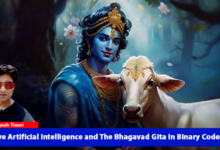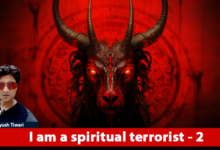
|
Getting your Trinity Audio player ready...
|
The Panchakshara commencing with “Nagendra Haraya” is a sacred chant written by Adi Shankaracharya, the great Indian philosopher and theologian of the Advaita Vedanta tradition. It holds immense significance in the context of Advaita Vedanta, as it encapsulates the essence of this philosophical system and acts as a powerful mantra for spiritual seekers.
Advaita Vedanta is a school of philosophy that emphasizes the oneness of existence, the non-duality between the individual self (jiva) and the supreme reality (Brahman). It is an ancient system of thought that seeks to unveil the ultimate truth behind the apparent multiplicity of existence. Adi Shankaracharya was one of the most influential proponents of this philosophy and wrote numerous texts to expound its teachings.
The Panchakshara Nagendra Haraya, also known as the Shiva Panchakshari mantra, epitomizes the core principles of Advaita Vedanta. The mantra consists of five syllables: “Na-mah Shi-va-ya.” Each syllable holds profound symbolism and represents different aspects of the ultimate reality.
The first syllable, “Na,” represents the negation of the individual self, emphasizing the need to transcend the limited identification with the ego. Advaita Vedanta teaches that the ego, or the sense of separate selfhood, is illusory and ultimately leads to suffering. By negating the ego, one can realize their true nature, which is pure consciousness.
The second and third syllables, “Mah” and “Shi,” represent the qualities of divinity. “Mah” stands for the transcendent aspect of divinity, while “Shi” represents the immanent aspect. Advaita Vedanta posits that Brahman is both transcendent and immanent, pervading all aspects of creation while also transcending them. Through these two syllables, the mantra reminds us of the omnipresence and omnipotence of the supreme reality.
The fourth syllable, “Va,” signifies the removal of ignorance and the dawn of knowledge. Ignorance is considered the root cause of suffering, as it leads to the mistaken identification with the body and mind. Advaita Vedanta asserts that realizing one’s true nature as pure consciousness can liberate an individual from the cycle of birth and death. The syllable “Va” invokes the transformative power of knowledge, which enables the seeker to transcend the limitations of the material world.
The final syllable, “Ya,” represents the harmony between the individual and the supreme reality. It signifies the merging of the jiva (individual self) with Brahman. In Advaita Vedanta, the realization of oneness is the ultimate goal, where the individual self recognizes its true nature as identical to the supreme reality. This syllable serves as a reminder of the inherent unity that underlies all apparent diversity.
By reciting the Panchakshara Nagendra Haraya mantra, one not only acknowledges the profound teachings of Advaita Vedanta but also invites the transformative power of the mantra into their spiritual practice. It acts as a potent tool for self-realization, enabling seekers to transcend their limited understanding and merge with the supreme reality.
The significance of this mantra lies not only in its metaphysical teachings but also in its devotional aspect. Through devotion and repetition, the practitioner cultivates a deep connection with the divine. The Panchakshara Nagendra Haraya mantra acts as a bridge between the aspirant and Brahman, allowing them to experience the mystical and transcendental aspects of reality.
So all in all the Panchakshara Nagendra Haraya mantra holds immense importance in the context of Advaita Vedanta. Its five syllables encapsulate the core principles of this philosophy, reminding seekers of their innate divinity and the ultimate goal of self-realization. Through devotion and practice, this sacred chant becomes a powerful tool for spiritual growth and transformation, guiding individuals on their path to realizing the timeless truth of Advaita Vedanta.
Lyrics
English
Aum namah shivaya shivaya namah aum
Aum namah shivaya shivaya namah aum
nagendraharaya trilochanaya
bhasmangaragaya mahesvaraya
nityaya suddhaya digambaraya
tasmai na karaya namah shivaya
mandakini salila chandana charchitaya
nandisvara pramathanatha mahesvaraya
mandara pushpa bahupushpa supujitaya
tasmai ma karaya namah shivaya
shivaya gauri vadanabja brnda
suryaya dakshadhvara nashakaya
sri nilakanthaya Vrshadhvajaya
tasmai shi karaya namah shivaya
vashistha kumbhodbhava gautamarya
munindra devarchita shekharaya
chandrarka vaishvanara lochanaya
tasmai va karaya namah shivaya
yagna svarupaya jatadharaya
pinaka hastaya sanatanaya
divyaya devaya digambaraya
tasmai ya karaya namah shivaya
panchaksharamidam punyam yah pathechchiva
sannidhau shivalokamavapnoti sivena saha modate
Sanskrit
नागेन्द्रहाराय त्रिलोचनाय
भस्माङ्गरागाय महेश्वराय ।
नित्याय शुद्धाय दिगम्बराय
तस्मै नकाराय नमः शिवाय
मन्दाकिनीसलिलचन्दनचर्चिताय
नन्दीश्वरप्रमथनाथमहेश्वराय ।
मन्दारपुष्पबहुपुष्पसुपूजिताय
तस्मै मकाराय नमः शिवाय
शिवाय गौरीवदनाब्जबृंदा
सूर्याय दक्षाध्वरनाशकाय ।
श्रीनीलकण्ठाय वृषध्वजाय
तस्मै शिकाराय नमः शिवाय
वशिष्ठकुम्भोद्भवगौतमार्यमूनीन्द्र देवार्चिता शेखराय ।
चन्द्रार्कवैश्वानरलोचनाय
तस्मै वकाराय नमः शिवाय
यज्ञस्वरूपाय जटाधराय
पिनाकहस्ताय सनातनाय ।
दिव्याय देवाय दिगम्बराय
तस्मै यकाराय नमः शिवाय
पञ्चाक्षरमिदं पुण्यं यः पठेच्छिवसंनिधौ ।
शिवलोकमावाप्नोति शिवेन सह मोदते
Meaning
He who has the king of snakes as his garland and who has three eyes,
He whose body is smeared with sacred ashes and who is the great Lord,
He who is eternal, who is ever pure with the four directions as his clothes,
Salutations to that Shiva, who is represented by the syllable “na”
He who is worshipped with water from the Mandakini river and smeared with sandal paste,
He who is the lord of Nandi and of the ghosts and goblins, the great Lord,
He who is worshipped with Mandara and many other flowers,
Salutations to that Shiva, who is represented by the syllable “ma”
He who is auspicious and who is like the newly risen sun causing the lotus-face of Gauri to blossom,
He who is the destroyer of the sacrifice of Daksha,
He who has a blue throat and has a bull as his emblem,
Salutations to that Shiva, who is represented by the syllable “shi”
He who is worshipped by the best and most respected sages – Vasishtha, Agastya and Gautama, and also by the gods, and who is the crown of the universe,
He who has the moon, sun and fire as his three eyes,
Salutations to that Shiva, who is represented by the syllable “va”
He who is the embodiment of yagna (sacrifice) and who has matted locks,
He who has the trident in his hand and who is eternal,
He who is divine, who is the shining one and who has the four directions as his clothes,
Salutations to that Shiva, who is represented by the syllable “ya”
He who recites this Panchakshara near Shiva,
Will attain the abode of Shiva and enjoy bliss.





